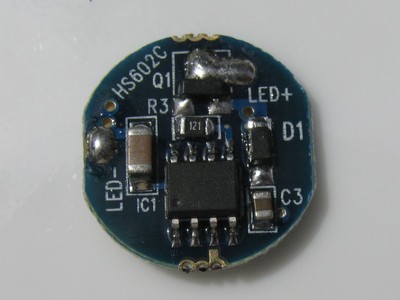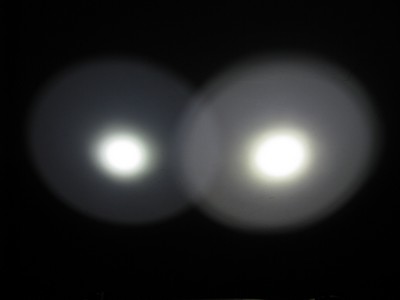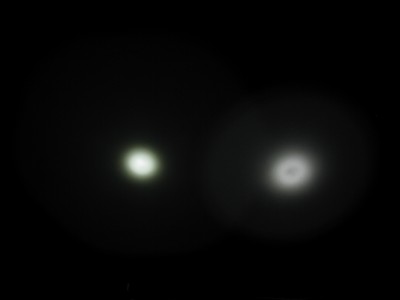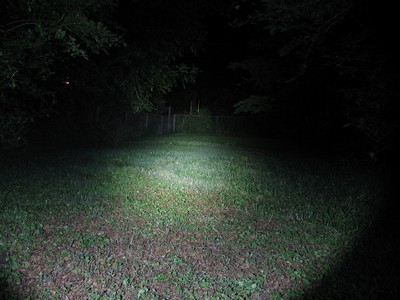Ultrafire WF-501B with MC-E Drop-in
Reviewer's Overall Rating: ***
Summary:
| Battery: | 1x18650 |
| Switch: | Reverse clicky |
| Modes: | 5 (H-M-L-S-SOS) |
| LED Type: | Cree MC-E M bin |
| Lens: | Glass |
| Tailstands: | No |
| Price Payed: | $20.00 |
| From: | DealExtreme |
Pros:
- Bright
- Cheap
- Mode memory works well
- Nice Low
Cons:
- Under-driven
- Dark donut hole in beam
- Current not well-regulated
- Whines on medium
- Host can't handle heat
Features / Value:****
DealExtreme introduced these MC-E "Bin M" lights at an irresistible price of $20. A drop-in with a P7 is over $17, and the M bin promises to be just as bright as the C bin P7. Plus I have XR-E, XP-E, XP-G, and P7 LED lights already, so having an MC-E would add another type of LED to the collection. Lastly, I had the Ultrafire 504B and 502B, so I figured it wouldn't be bad to have a 501B to go along with those.
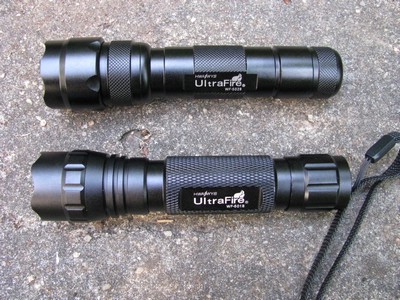
Don's review said he was very impressed with the light and that it was drawing 2.5A at the tail and didn't have much a donut hole. Knowing that DX quality varies greatly, I went ahead and bought one. It took a little over a week for the item to get in stock which worries me that they had run out of the initial run of lights and were hard at work scrounging cheaper parts to make more.
I wasn't crazy about having 5 modes, but with such a good current draw, I figured I could live with the SOS and strobe. The brightness levels seemed spaced out pretty well too. The driver also has well-functioning memory, where the last mode is memorized if the light stays off for more than about 2 seconds. Anything less than that and it skips to the next mode. One second would be better, but I can definitely live with 2-second memory. And it beats the memory that is based on how light the light is on.

So on paper this light is a great value. However, the light I got doesn't have anywhere near the 2.5A current draw (1.4-1.6A) and therefore is much less bright. I have no idea if it is really a bin M brightness. Also the beam has an ugly dark donut hole in the middle that is pretty obvious (on white walls at least) at any distance over 1 meter. Those two things really knock the value down for me.
Build Quality: ***
I was wary of the Ultrafire WF-501B host. I knew it was lighter weight with less heat sinking than the 502B or 504B. However, I was impressed with the overall quality of the host. Yes, it is lightweight, but the machining seems pretty good. There is a small ding in the knurling to the right of the name label, but otherwise it is pretty much perfect. Like the 502B, the light is in 4 pieces: head, throat, body, and tail. There are o-rings at each location and they were lubed. The threads were pretty rough and it can be a little difficult getting started when screwing two pieces together. There aren't many threads in each location, particularly the tail which only has 3 threads. The throat is a little big for the drop-in so, as with my other hosts, I wound up putting in a few layers of aluminum cut from a soda can. In this case, 4 layers seems to do it which is the same as the 504B and less than the 502B. This seems to help the heat sinking, but honestly it would be crazy to drive this thing at 2.5A or more for very long. My P7 light weighs a lot more and has amazing heat sinking and that whole light gets very hot in about 10 minutes.

The LED itself seems soldered in okay. It is pretty well centered on the pill and has thermal paste underneath. The pill itself gets hot quickly, so I think the LED is mounted properly. The soldering on the back of the board seems fine too and makes a good smooth connection with the pill.
The tail switch is very firm, but works fine and is easy to do half-presses to change modes. The only thing I don't like there is they use a smooth black rubber switch cover and I would rather have one with texture on it like the 504B has. The 502B was the same way so I already have some switch covers to use as replacements. Although the light seems like it is very similar to the 502B, there are a lot of cosmetic differences which you can see in the picture.
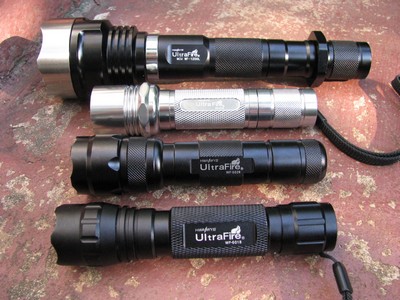
Battery Life: ?????
Even though this light draws less current than it should, I don't know if it is a good idea to try a duration test on it. With a draw of 1.4A, it should last at least an hour, but if it really drew 2.5A it would be more like 30 minutes and I don't think you could get rid of the heat fast enough to avoid damage to the LED.
Instead I charged some batteries down to different voltage levels and took current draws at each. I am using gray 2400mAh protected 18650's: two are Ultrafire and two are Trustfire. These are the same batteries I have used in other tests. I am not testing output current or voltage drop across the LED, so I can't measure driver efficiency (maybe later when I replace the driver). These are just tailcap draws. Out of curiosity I also did a measurement with just a battery and the drop-in and got maybe 100mAh higher draw, so I don't think there are any bad contacts in the host body itself.
| Voltage | High | Medium | Low |
|---|---|---|---|
| 4.16V | 1430mA | 510mA | 60mA |
| 4.06V | 1310mA | 480mA | 60mA |
| 3.78V | 940mA | 340mA | 40mA |
| 3.63V | 850mA | 300mA | 40mA |

After writing the review, I replaced the driver with a 2.8A 3-mode driver from Shiningbeam, so I took the original driver out. I measured 1.25A going to the LED with a 1.4A draw at the tail, so the driver is pretty efficient. The driver itself had silicone thermal adhesive all over it. I'm not sure if this is for heat transfer (doubtful), ruggedness (keeps the pieces from coming loose), or an attempt to stop PWM vibration and whine. I scraped off as much as I could and the driver seems pretty simple:

It seems to be basically the same driver as the one in my Ultrafire WF-504B with XR-E R2, but that one was rated at 1000mA:
Light Output: ****
Compared with my 502B which has a XP-G R5 driven at 1.05A, the MC-E puts out more light. But it should be putting out almost twice as much light and that definitely isn't happening. Also the intensity is less and of course there is the donut hole. I knew that most multi-emitter LED's are going to have a donut hole or a plus in the beam, so this was expected, but it is more prominent than I thought. Both of these lights have a cool white tint.
Here is a series of pictures comparing the 502B XP-G R5 on the left with the 501B MC-E on the right. The pictures are taken at an ISO of 100 f/2.8 and I step down the shutter speed as noted. The lights are 0.5m from the wall and both have a fresh battery. Here are both lights on High with the exposure at 1/25th second: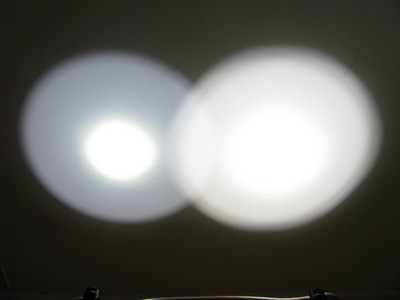
and at 1/1600th second (now the donut shows up, but really it is always visible):
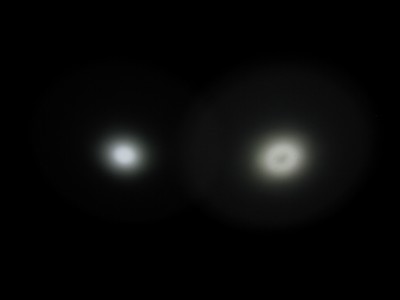
I will save a comparison of Medium and Low for outdoor shots later on. Now here is my Ultrafire MCU WF-1200L with a P7 LED driven by 2 18650 batteries vs. the 501B. These should be about the same brightness overall, but the bigger reflector of the 1200L will give it a tighter hotspot. The 1200L has a plus-shaped hole in the beam, but it is nowhere near as prominent as the one in the 501B. Here are both lights on High at 1/25th second:
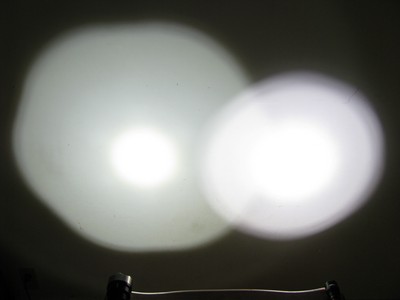
And at 1/200th second. The P7 has a greenish tint:
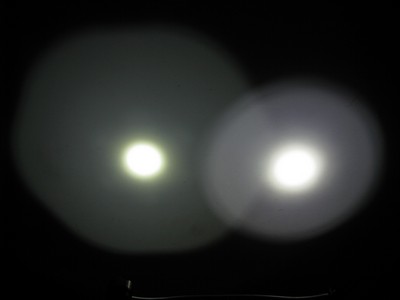
You can see the donut hole at 0.5m, but it becomes more prominent as you get further from the wall. Here it is at 1.5 meter from the wall and a 1/400th second exposure. Later I swapped out a reflector I had in a XR-E drop-in and it made the hole a little smaller. The first picture is the original hotspot and at right is the hotspot with the replacement reflector.
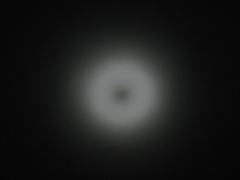
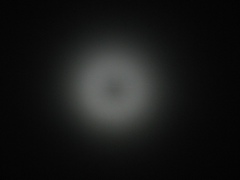
The light uses PWM on Medium and Low, but it isn't noticeable and a time exposure photo yields a smooth line when moving the light quickly. The Low is pretty decent. The light tends to have an audible whine on Medium, but not Low.
One tree in my backyard is really overgrown right now, so I had to shift my usual range. The fence post is now 80 feet away (in other reviews it is 120 feet away). These pictures are taken with a 4 second exposure to get something like what it looks like in person. For comparison, here is the 502B first with a XP-G R5:
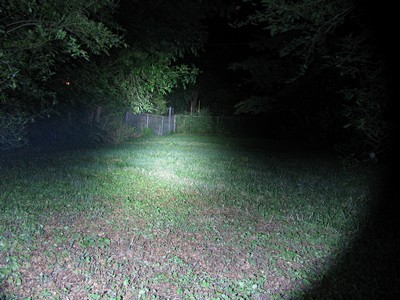
Now here is the 501B with the MC-E on High. The fence post is actually in the donut hole so it doesn't look quite as bright, but otherwise the 501B puts out more light than the 502B. It is hard to see the donut hole in this picture, but when you are moving the light around it is almost like a pointer or like a bug is on the lens:
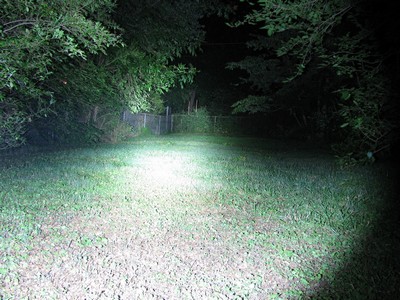
Now here is my Ultrafire WF-504B with a Cree XP-G R4 neutral white LED. The camera compensates for the tint, so you can't much of a difference in tint. This LED is driven at 1400mA whereas the 502B is driven at 1050mA.
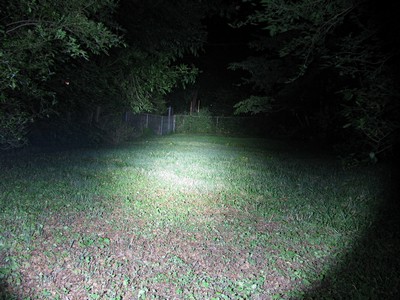
Now here is the Ultrafire WF-1200L with a P7. It has great throw:
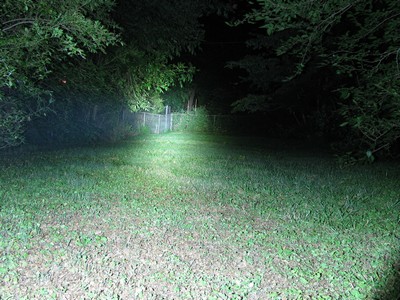
Now here is the fence at the middle of the picture zoomed in (502B, 501B, you can't open these for larger versions):


Now the 504B which doesn't throw that well, and the 1200L which lights up trees well past the neighbor's tomato plants:

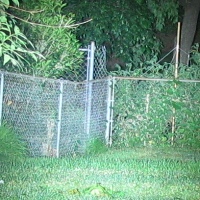
Here are the same 4 lights on Medium. First the 502B:
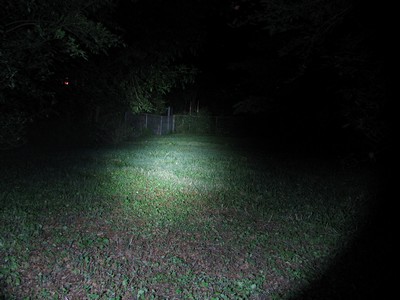
Now the 501B (again, the fence post is in the donut hole):
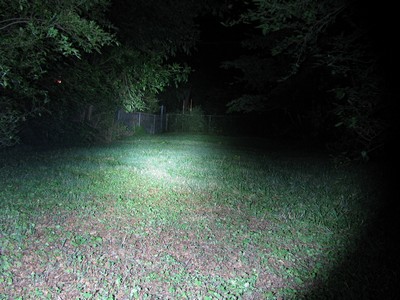
Now three lights on Low (the 1200L doesn't really have a Low). First the 502B:

Now the 501B. The Low is significantly brighter than the 502B, but is still pretty good:
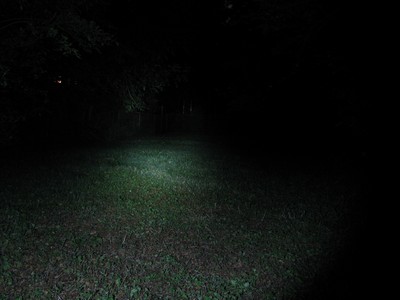
Summary:***
This light would be a great value if it could correct the big donut hole and drive the LED per the specifications. It shouldn't be a problem getting a better driver, but it will cost about $9, a big chunk of the price of the light. I may be able to tweak the donut hole by unscrewing the reflector a little, but I don't think the 501B host has room for a longer drop-in.

